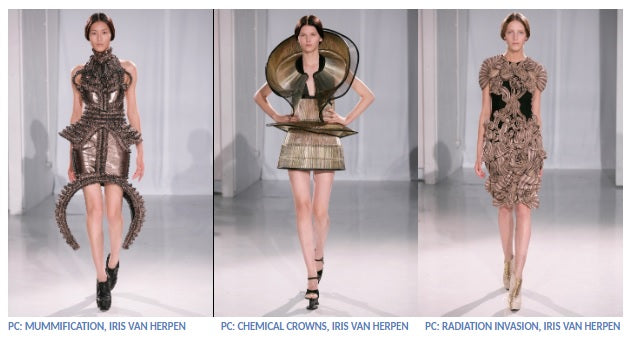Author: Baishakhi Ghosh
3D printing, more professionally known as additive manufacturing, has been in use for nearly a decade by scientists and architects who utilize this technique for building 3D models. Through the years 3D printing has proved versatile with many usages in a multitude of industrial sectors as it provides extreme precision and ease of manufacturing from scratch without the need of any other tools. It is usually done by layer to layer construction inside the printer using easily available input materials that are not only cost-effective but also time-saving when it comes to large scale manufacturing.
The fashion industry hasn’t been any exception to this industrial revolution, which some term as the Fourth Industrial Revolution. From accessories and shoes to clothes and jewellery, there’s no limit to the scope of 3D printing. Once only found in large labs and manufacturing industries, 3D printers have become more accessible in the recent years, allowing fashion designers to experiment with them from the comfort of their home.
3D printing provides immense advantages over the traditional methods of manufacturing a garment. It does not require any mould and can be used to create highly detailed textile pieces with desired qualities such as flexibility, opaqueness, rigidity, waterproofing etc. It completely does away with the lengthy multi-process traditional methods which involve cutting and sewing of patterns, as 3D printers can produce whole garments with just a simple template fed into the printer with input construction materials.
Iris Van Herper’s fashion show “Crystallisation” (2011) in collaboration with Daniel Widrig, a London architect, at the Paris Fashion Week, saw a successful attempt at garments created using 3D printing. At present, 3D printing is limited in its application as it can be used to create specific geometric structures and meshes only.

Danit Peleg made game-changing progress in 3D printing during the time of her graduation in which she created a collection of 3D printed garments at her home without any prior technological skills in this department. You can even buy your own customized outfits on her website if the fancy strikes.

Besides garments, 3D printing has been applied in making fashion accessories such as eyewear too. Mykita and Ic! is the first company that started making customized glasses from 2009. Other brands such as Safilo and Monoqool also manufacture glasses using 3D printing technology.
Gemmyo and Goossens are two of the brands that manufacture 3D printed accessories and jewellery. Brands like Reebok, Nike, and Adidas also use 3D printing for manufacturing their shoes. The ability of 3D printers to create complex structures is sought after by these sneaker brands as it allows for more refined soles and better construction, besides providing immeasurable purview for experimentation.
Though the usage of 3D printing in fashion is still at a rudimentary stage, the future scope for evolution is promising. According to Danit Peleg, 3D printing shows prospects of consumers being able to create their own garments in the near future from the comfort of their home. It will be fascinating to see how 3D printing evolves and revolutionizes the fashion industry towards a more cost-effective and time-saving alternative for consumers.

